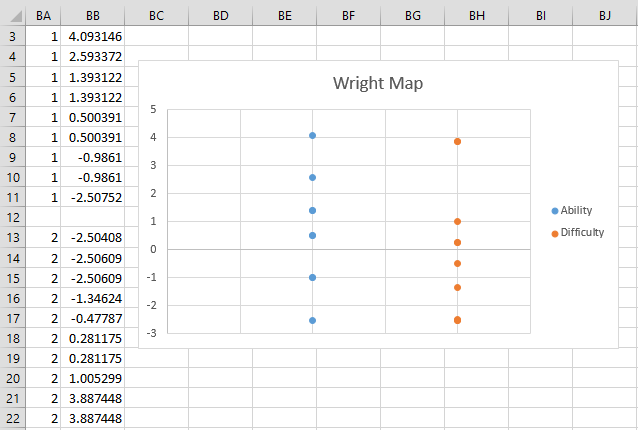Objective
A Wright Map is another useful tool for evaluating a questionnaire in conjunction with a Rasch model. We now show how to create a Wright Map, as displayed in Figure 1, based on the data from Figure 5 of Building a Rasch Model.
Creating the data
The ability values for the nine subjects A through I are shown in range BB3:BB11. The difficulty values for the ten items 1 through 10 are shown in range BB13:BB22.
Figure 1 – Wright Map
The data on the left side of the figure is constructed by placing a 1 in column BA for each subject and then inserting =AX4 in cell BB3, highlighting range BB3:BB11 and pressing Ctrl-D. Similarly, place a 2 in column BA for each item and then insert in range BB13:BB22 the array formula =TRANSPOSE(AN13:AW13).
Drawing the chart
Next, highlight the range BA3:BB11, and select Insert > Charts|Scatter to draw the blue dots on the left side of the chart in Figure 1. Now, click on the chart and select Design > Data|Select Data to add another scatter chart based on the data in range BA13:BB22, which adds the red dots to the right side of the chart.
You can now add the chart title and legend, as well as remove the horizontal axis. This can be done by right-clicking on the horizontal axis and selecting the Format Axis… option from the dialog box that appears. You then need to select Labels and set the Label Position to None.
We see from the Wright Map that the Ability values are evenly spaced on the chart, which is desirable, although there are three redundant pairs (C and D, E and F, G, and H). There is a gap in the Item values between 1 and 4, which is not desirable.
Examples Workbook
Click here to download the Excel workbook with the examples described on this webpage.
References
Moultan, M. H. (2003) Rasch estimation demonstration spreadsheet
https://www.rasch.org/moulton.htm
Wright, B. D. and Stone, M. H. (1979) Best test design. MESA Press: Chicago, IL
https://research.acer.edu.au/measurement/1/
Wright, B. D. and Masters, J. N. (1982) Rating scale analysis. MESA Press: Chicago, IL
https://research.acer.edu.au/measurement/2/
Wright, B. and Stone, M. (1999) Measurement essentials, 2nd ed.
https://www.rasch.org/measess/
